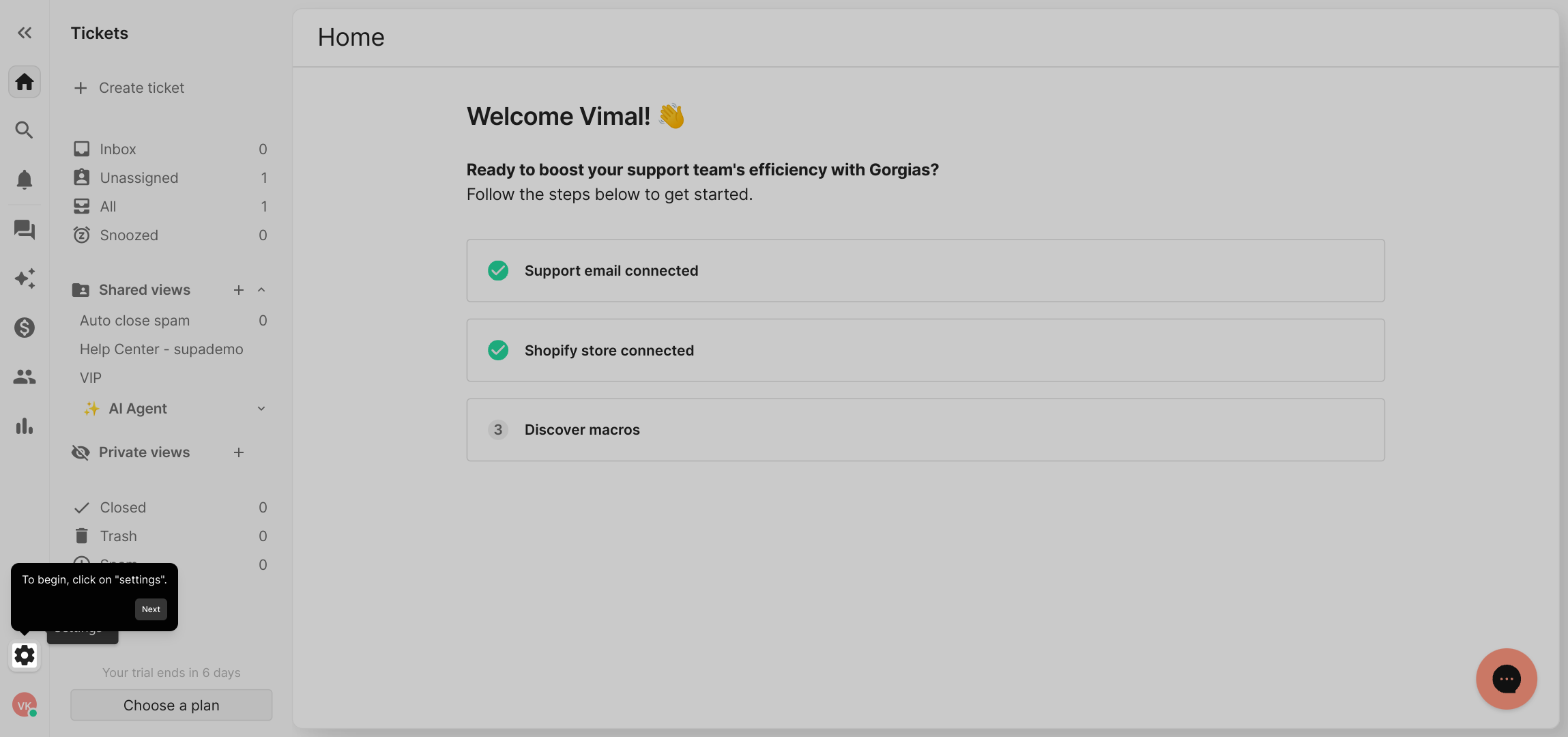1. To begin, click on "settings".
2. Start by creating a new tag like ‘GDPR Delete’ to help identify data deletion requests. To do this, click on "Tags."
3. Then, click on "Create tag".
4. Add the tag name as GDPR delete and click on "check".
5. Next, create an automation rule to detect common GDPR-related phrases and auto-tag the ticket. To do it, click on Rules.
6. Then, click on "Create rule".
7. Click on "Create Custom Rule".
8. Following that, add a rule to auto-tag tickets as GDPR delete if the message body of the tickets contains delete my data.
9. Finally, draft a macro to confirm the request has been received and explain your data deletion process.
10. Create a Supademo in seconds
This interactive demo/guided walkthrough on How to Automate GDPR-Compliant Data Deletion Requests in Gorgias was created using Supademo.
How to Automate GDPR-Compliant Data Deletion Requests in Gorgias : Step-by-Step Guide
Let’s start by opening the main settings menu from your dashboard. This is where you'll find all the options you need to customize your setup.

Next, navigate to the Tags section—this helps you organize and track requests efficiently. Here, you’ll create a new tag, such as ‘GDPR Delete,’ which makes it easier to identify tickets related to data removal.

In the Tags area, you’ll see an option to add a new tag. Click on “Create tag” to begin setting up your custom identifier.

Now, type in the tag name—something like “GDPR delete”—then confirm your entry by clicking the checkmark. This tag will be used to flag relevant tickets moving forward.

With your tag ready, it’s time to build an automation rule that scans for typical GDPR-related phrases and applies the tag automatically. To start, go into the Rules section where automation options live.

Inside the Rules area, select the button labeled “Create rule” to begin crafting your new automation.

Next, choose “Create Custom Rule” so you can define specific conditions tailored to identify GDPR delete requests.

Set up the rule to look for the phrase “delete my data” anywhere in the ticket’s message body. When detected, this rule will automatically tag the ticket with “GDPR delete,” helping you prioritize these requests effortlessly.

To wrap things up, create a macro that sends an acknowledgment to users confirming their deletion request has been received. This macro can also explain how your data deletion process works, providing clarity and reassurance.

With all these steps completed, you’ve streamlined your GDPR data deletion workflow. Now, enjoy the ease of managing requests quickly and professionally with your new setup.

Create your own interactive demos in < 5 mins with Supademo
You can create your own interactive product demo in minutes using Supademo. Drive growth, scale enablement, and supercharge product-led onboarding with Supademo. Sign up for free here with no credit card required.
FAQs
What is GDPR-compliant data deletion?
GDPR-compliant data deletion means securely removing personal data from your systems upon a user’s request, ensuring their privacy rights are respected and legal obligations under the GDPR regulation are fulfilled.
Why automate data deletion requests in Gorgias?
Automating data deletion requests in Gorgias saves time, reduces human error, and ensures timely compliance with GDPR by promptly identifying and processing deletion tickets without manual intervention.
How do I create tags for GDPR requests in Gorgias?
Go to Settings, then Tags, and click "Create tag." Name the tag (e.g., ‘GDPR delete’) to help categorize and easily identify tickets related to data deletion requests.
What phrases should automation rules look for to tag GDPR deletion requests?
Common phrases include “delete my data,” “remove my information,” or “data deletion request.” Setting rules to detect these phrases helps auto-tag related tickets for quicker handling.
Can I customize the response sent to users after a deletion request?
Yes, by drafting a macro in Gorgias, you can customize acknowledgment messages that confirm receipt of the request and explain your data deletion process clearly to users.
Does automating GDPR data deletion in Gorgias ensure full legal compliance?
Automation helps manage requests efficiently, but full compliance requires proper offline processes, data backups management, and adherence to your organization's legal data policies.
What is the benefit of using macros in the GDPR deletion workflow?
Macros save time by providing standardized, pre-approved responses that acknowledge requests and guide users, ensuring consistent communication across teams.
How frequently should I update the GDPR automation rules in Gorgias?
Review and update rules periodically or when new data privacy requests emerge to maintain accuracy in detection and tagging of GDPR-related tickets.
Can I track the status of GDPR data deletion requests in Gorgias?
Yes, by tagging tickets and using automation, you can easily filter and monitor open, in-progress, and completed data deletion requests within your support system.
Is technical knowledge required to set up GDPR automation in Gorgias?
Basic familiarity with Gorgias’ interface is sufficient. The step-by-step guide simplifies creating tags, rules, and macros without needing advanced technical skills.

